Removable lower jaw prosthesis
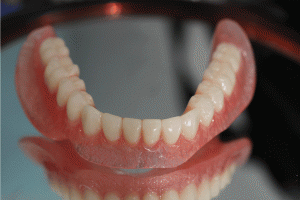
Removable dentures are dental structures that are used to restore the function of lost teeth and the aesthetics of the dentition.
The prostheses are called removable due to the fact that the patient can independently fix them in the oral cavity and remove them for hygienic care and cleansing.
Removable structures are used to restore the integrity of the dentition, if there are the following indications:
- Single and multiple defects of the dentition.
- Complete absence of teeth on the upper or lower jaw.
- The presence of end defects of the teeth.
- The inability to install a fixed prosthesis.
- For splinting teeth when loosening.
- Periodontal disease.
- As temporary designs to restore aesthetics.
Kinds
Removable structures may be full or partial, temporary or permanent.
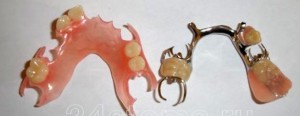
- Complete removable dentures are made of nylon or acrylic plastic and are used with completely missing teeth on the upper or lower jaw. The prosthesis is fixed due to the suction effect.
- Partial constructions are used for the loss of one or more teeth. They can be made of plastic or clasp. Partial dentures are fixed in the oral cavity using hooks (clasps).
- Temporary prostheses are intended for use during the manufacture of a permanent structure.
- Permanent design is used for continuous wear.
Features of prosthetics of the lower jaw
A removable denture on the lower jaw is made with complete or partial absence of teeth.
Prosthetics with full removable structures of the lower jaw can present some difficulties associated with an insufficient amount of space for supporting the base.
- The presence of folding of the mucous membrane, frenulum and cords prevents the qualitative fixation of the prosthesis using the valve mechanism.
- The tongue and cheeks contribute to the displacement of the structure, which causes its incorrect position, causing discomfort in the patient.
- In this regard, if there is at least one healthy tooth on the lower jaw that could hold the clasp and perform the function of support, you must try to do everything to preserve it, since partially removable structures will be preferable for prosthetics of the lower dentition. .
- For prosthetics of the lower jaw, the best option would be a hard acrylic prosthesis (if there are no contraindications to the use of plastics). The plastic structure holds its shape better and does not undergo deformation in the oral cavity.
- For better fixation of the removable prosthesis, special fixation tools can be additionally used.
Clasp prosthesis on the lower jaw
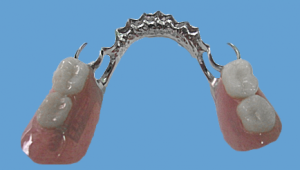
For prosthetics of the lower jaw, a design is used, the metal arch of which is located on the lingual side between the gum and the bottom of the oral cavity.
Fixation of the clasp prosthesis on the lower jaw is carried out using clasps, locks (attachments) and telescopic crowns.
Clasp design with locks
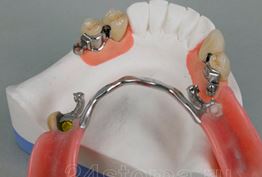
One of the parts of the lock is fixed to the abutment, and the second is embedded in the metal frame of the prosthesis.
Advantages of locking:
- Attachments are not noticeable when smiling and talking.
- Reliability of fixing the structure.
- Durability.
Clasp prosthesis with clasp fixation
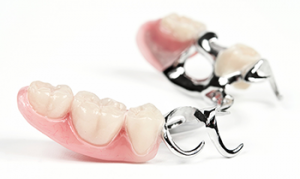
The advantages of the design are that:
- Clasps cover abutment teeth and securely fix structures in the oral cavity.
- To install a clasp prosthesis with a clam clamp, there is no need to dissect the abutment teeth.
- Shown as splinting design when loosening teeth.
The disadvantages of prostheses with clasps are that they are noticeable when talking and smiling.
Dentures on telescopic crowns
In this case, the fixing element is a telescopic crown. It consists of two parts: removable and non-removable. The removable part is attached to the base of the prosthesis, and non-removable to the abutment.
The advantages of this design are the reliability of fixation and high aesthetics. Dentures on telescopic crowns have one drawback, which boils down to the preparation of supporting teeth.
Implant prosthetics
With full adentia of the lower jaw, the most optimal option may be prosthetics on implants.
Implant prostheses have the following features:
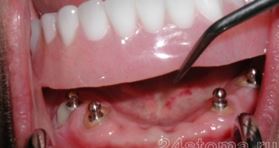
- Reliability of fixing the structure on implanted titanium screws.
- Recovery of all tooth roots is not required. It is enough to carry out the implantation of several implants, which will become the support of the removable structure.
- The prosthesis can be easily removed in the dentist's office in order to carry out cleaning, repair or replacement of the structure.